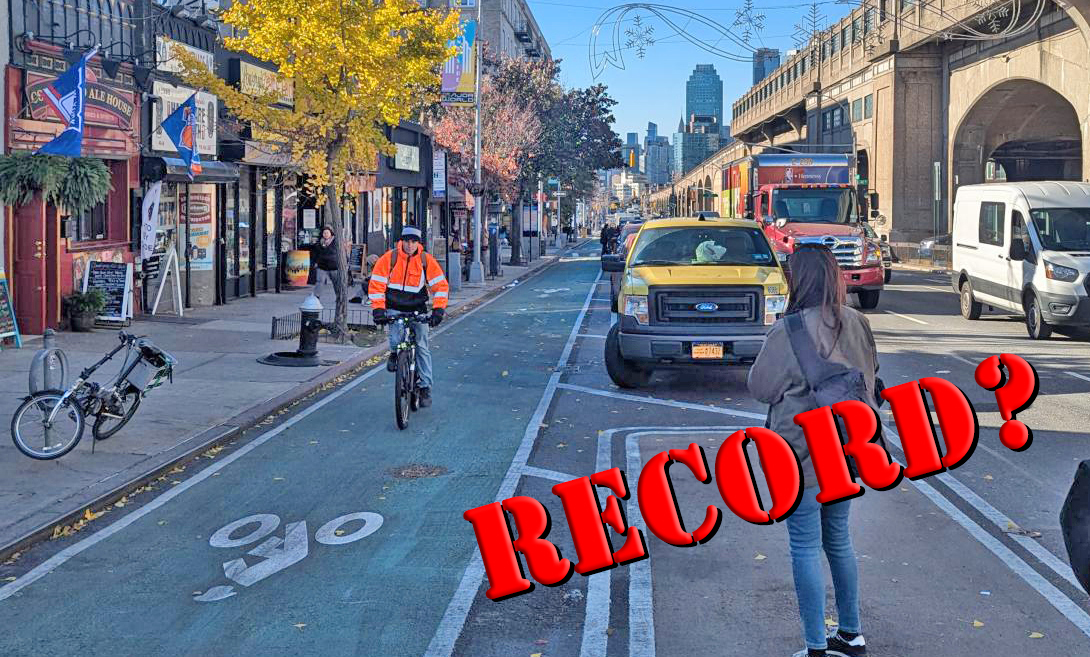Albany’s latest raid of transit funds could hit New York City particularly hard. To help pay for his upper-middle-class tax cut, Governor Andrew Cuomo and the state legislature are stripping an estimated $320 million a year in revenues from the MTA payroll tax. Although the legislation is said to contain a pledge to find equivalent funds elsewhere, the as-yet unspecified reimbursement mechanism is likely to make the transit agency more vulnerable to future cuts, as Streetsblog noted last week.The potential deterioration in service could easily end up costing drivers and transit riders more in lost time and damaged health than they will gain in lower taxes.

To gauge the impact, I entered $320 million worth of cuts in subway operations into my Balanced Transportation Analyzer (BTA) spreadsheet, which combines New York City traffic, transit and revenues into a single model. Here’s what it predicts for city residents, workers and visitors in a worst-case scenario, in which Albany breaks its promise to replace the money, and all of the resulting cuts fall on subway service:
- A nearly 3 percent lengthening in the average duration of subway trips, as maintenance is curbed and service curtailed.
- A 2 percent drop in subway ridership triggered by the poorer service.
- An additional 13,000 more cars driven into the Manhattan Central Business District each weekday, as some frustrated subway riders elect to drive rather than wait for trains.
- An average 2 percent drop in vehicle speeds within the CBD and 0.5 to 1 percent on the approaches, a consequence of cramming more vehicles onto already jammed streets, highways and bridges.
- More pollution and traffic crashes, and less biking and walking, caused by the rise in driving.
- An estimated 27,000 fewer people journeying to the Manhattan CBD on a typical day -- a drop of 0.8 percent -- because only some of the lost subway trips are replaced by cars and taxicabs.
- A further shortfall of $40 million in MTA revenues as subway ridership declines.
Drivers’ and straphangers’ lost time -- an estimated 23 million hours a year -- can be expressed in dollar terms; so can the environmental consequences from the increased gridlock. Through a set of calculations that reflect the spectrum of “values of time” — more for an 18-wheeler than a car, for example — the BTA calculates the lost time at $450 million a year ($260 million for drivers and truckers, $190 milion for subway and bus riders). Tack on to that $90 million in worsened health due to the increased pollution and decreased biking and walking, plus the $40 million in reduced farebox revenues. Lost business income and tax revenues from the nearly 1 percent drop in person-trips to the CBD would compound these figures.
Under this scenario, New Yorkers’ $320 million in tax savings are swamped almost two-to-one by the $580 million in costs detailed above.
While belt-tightening by the MTA might soften the blow, the cost-cutting in recent years means that new cuts are likely to take out muscle instead of fat. The rise in congestion costs might also be eased by cutting bus service instead of subways, since most bus trips are outside the CBD, where gridlock is less endemic. But insofar as bus riders have lower average incomes than subway riders, the equity impacts would be even worse.
In the modeling, reduced transit budgets translate to longer transit travel times, which depress transit use. Some of the lost transit trips switch to autos (the conversion rate is around 70 percent for commute trips and 40 percent for other trips). In turn, the rise in auto trips is tempered somewhat by the tendency of some drivers to stay home rather than battle the increased traffic.
Contrary to voguish notions of tipping points, the modeling in the BTA -- drawn from empirical data and embodied in a host of interactive equations -- assumes that any change in travel cost or time evokes a commensurate change in behavior. Though it may seem surprising that tacking a mere minute onto a 20- or 30-minute subway journey should cause anyone to forego the ride, the fact is that many travel choices are balanced on a fine edge between transit or car or cab or bike or walk or stay home. At “the margin” where choices are made, changed service quality makes a difference.
Disturbingly, no State Senator or Assembly member asked last week whether cutting the MTA payroll tax might worsen transit service and compound highway gridlock. Then again, Governor Cuomo didn’t give them much time, handing them what was essentially a done deal. (The Times reported a NYPIRG source saying the bill was posted 26 minutes before voting began.) Legislators may also not have grasped that households earning $300,000 to $2 million a year would get steeper tax cuts than the middle- or working-class families that were touted as the main beneficiaries.
Could Albany have paid for the payroll tax cut and kept transit whole simply by zeroing out the tax break for incomes over $300,000? The governor and legislative leaders sealed their deal with such haste, shielding details from scrutiny, that even as of this writing there’s no way to tell.





